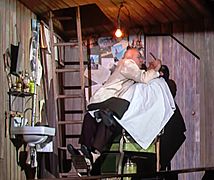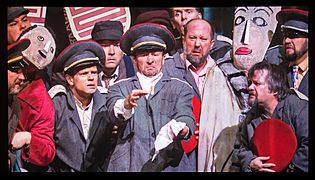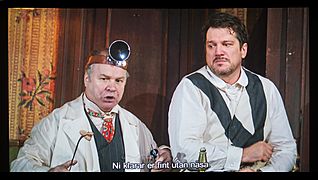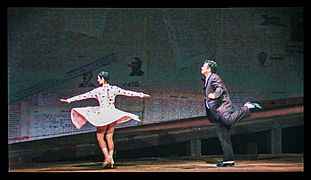The Nose (opera) facts for kids
The Nose is a funny and unusual opera written by Dmitri Shostakovich. He was a famous Russian composer. He wrote this opera in 1927. At that time, many exciting new movies and plays were being made in the Soviet Union.
Shostakovich was only 20 years old when he started writing The Nose. He wanted to make Soviet operas more interesting. He based the story on a short story by Nikolai Gogol. It's about a man who wakes up one day and finds his nose has disappeared!
The opera was first performed in 1930. But soon after, the performances had to stop. This was because of the political situation in the Soviet Union, which was ruled by Stalin. Many music critics wrote bad things about the opera. It was not performed again in the Soviet Union until 1974.
The Nose is a satire. This means it uses humor to make fun of people or ideas. In this opera, it pokes fun at bureaucrats. These are people in official jobs who think they are more important than they really are.
Contents
The Opera's Story
The story begins with a barber named Ivan Yakovlevich. He is shaving a man called the Major. The next morning, Ivan wakes up and his wife gives him some fresh bread and onion. When he cuts the bread, he finds a nose inside! His wife screams and chases him out of the house.
Ivan runs down the street with the nose. He feels very embarrassed. He tries to throw the nose into the river. But a policeman catches him. Ivan tries to bribe the policeman, but it doesn't work.
The Major's Missing Nose
In the next part of the story, the Major wakes up. He finds that his own nose is gone! He goes to tell the police. On his way, he goes to the cathedral. There, he sees his nose! The nose is dressed up like an important person. Yes, the nose is now a person, sung by a singer!
The Major is confused. He doesn't know what to say to his nose. This is because his nose now seems more important than he is. He can't speak clearly, and the nose doesn't understand him. The nose speaks very confidently, like someone of high rank.
The Major can't find the Chief of Police. So, he goes to the newspaper office. The people there laugh at him. They say they can't print a notice about a lost nose. They think it would make their newspaper look silly. They tell him to see a doctor.
When the Major takes his handkerchief away from his face, the newspaper staff get interested. They see he really has lost his nose. They think it could be a good story. They offer him some snuff. Of course, he can't sniff it, and he gets very angry.
The Chase for the Nose
The police are looking for the lost nose. They watch people getting into a coach. They think the nose might be trying to leave the city. As the coach leaves, the nose runs in. It tries to stop the coach and frightens the horses. The driver tries to shoot the nose. Everyone starts to fight the nose, hitting it until it is back to its normal size.
The policeman wraps the nose in paper. He returns it to the Major and asks for money. The Major tries to stick his nose back on his face, but he can't. Even the doctor can't do it. The nose then escapes into the crowd.
The Major thinks a woman named Madame Podtochina used witchcraft on him. She had tried to make him marry her daughter. He writes to her, asking her to stop the spell. But she writes back, thinking he wants to marry her daughter! Large crowds appear on the street, trying to see the nose.
In the last part of the opera, the Major has his nose back where it belongs. The barber shaves him. Then, the Major walks proudly along the street, showing everyone his nose.
The Music of The Nose
The music in The Nose is perfect for a satire. It helps tell the funny and strange story. For example, the policeman sings in a high, squeaky voice. The music at the beginning sounds a bit like circus music.
At the end of the scene where the Major tries to bribe the police officer, there is music just for percussion instruments. This part is very famous and is often played by itself. One of the barber’s songs is played with four balalaikas. Madame Podtochina’s daughter sings like a romantic opera singer. The waltz sung as people get on the coach is a parody waltz, meaning it makes fun of a typical waltz.
- '''The Nose''' Live in HD, 2013
See also
 In Spanish: La nariz (ópera) para niños
In Spanish: La nariz (ópera) para niños







